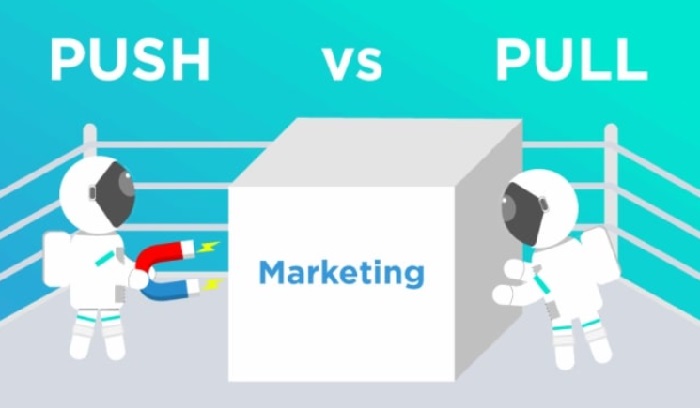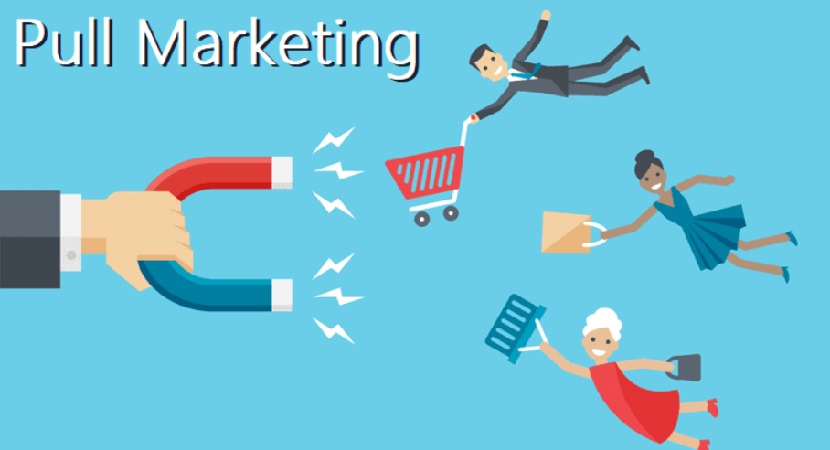Push marketing is a marketing strategy that businesses use to promote their products to their customers, whereas pull marketing strategy involves drawing customers through a more natural approach. In this article, we will learn more about push vs. pull marketing.
The advertising or marketing strategies are broadly classified into two types. They are called pull and push marketing strategies. The concept revolves around a pull advertising strategy focusing on the right man at the right time. On the other hand, a push marketing strategy focuses on promoting their products or services on a relatively broader scale.
This article will tell you more about these strategies and how they differ.
What is the Difference between the Push and Pull strategy?
The target customers would already be acquainted with the product or service offered in a push marketing strategy. It focuses on promoting its products or services on a relatively broader scale. This consists of low costs and focuses mainly on making your products or services more visible to customers. However, this strategy requires the customers to be aware and familiar with what they offer.
Following are the circumstances where this strategy is more helpful:
- While planning to expand or reach out to a broader niche, this strategy is beneficial.
- A push strategy will assist your business in brand promotion. This will work out, especially when greater market competition exists.
- You may use this strategy to establish a new business or niche without existing goodwill or standing.
- A push strategy is a reasonable solution to yield quick sales and cash flow.
- If you wish to reach out to your target customers during holidays or other festivities.
- For subsidizing a strategy including multiple channels, push marketing may be done.
- While going for temporary campaigns to promote your business.
- This strategy works efficiently when releasing your customers a new category or product.
- You may opt for this approach to clear out the end-of-season leftover stock.
For example, push strategy includes billboards, displaying ads, pay-per-click (PPC), and direct marketing.
Pull strategy
A pull marketing strategy involves drawing customers through a more natural approach. Focuses on the concept of the right man at the right time. This form of marketing is more active and aggressive. Moreover, it is known for having sales for a product that does not have any existing demand. However, in a pull marketing strategy, the information must adequately be explained, and the customers must be informed.
Read more – What is Pull Marketing? Best Examples in 2024
Following are the circumstances where this strategy is beneficial:
- When you wish to promote your brand, i.e., to increase brand awareness among your customers.
- This helps in increasing your brand visibility among your target customers.
- This strategy may be opted for to enable the long-term growth of the brand or business.
- It helps maintain a dominant position in the industry where one is functioning.
- Pull strategy assists in increasing loyalty concerning your brand among your target customers.
- This strategy will be beneficial when you desire to boost your site’s traffic or, otherwise your social media traffic.
- You may implement this approach to improve your revenue and sales at a reasonable budget or amount.
For instance, this strategy consists of Search Engine Optimization, Social media marketing, blog articles, etc.
Push vs. Pull marketing
Type of Product
The target customers would already be acquainted with the product or service offered in a push marketing strategy. However, in a pull marketing strategy, the information must adequately be explained, and the customers must be informed.
Scope of Reach
Pull marketing consists of a relatively narrower approach and is highly capital-intensive. Whereas push marketing strategy consists of low costs and is a more minimal but broader approach. Push strategy focuses on making the products or services you offer more visible.
Cost
At the core, the costs incurred may depend on several factors: your product or service, distribution channels, your target audience, etc. But, generally, a pull marketing strategy involves incurring relatively higher costs than push marketing.
Meaning
A push marketing strategy aims to ‘push’ what you offer to your target customers. On the other hand, pull marketing includes ‘pulling’ or drawing your customers to the products and services you offer.
Demand
Pull marketing is known for having sales for a product with no existing demand. However, push marketing requires the customers to be aware and familiar with what they offer.
Duration
A pull marketing strategy is a long-term advertising approach. In other words, the process involved is more time taking. In comparison, push strategies are more short-termed in nature.
Objective
A push marketing strategy aims to make quicker and more immediate sales. At the same time, pull marketing builds its customer base over a longer time. This form of marketing is more active and aggressive.
Forms
Push marketing strategy includes billboards, displaying ads, pay-per-click (PPC), and direct marketing. Pull marketing strategy consists of Search Engine Optimization, Social media marketing, blog articles, etc.
Communication
Communicating with the customers is optional in a push marketing strategy. While in a pull marketing strategy, the product or service information must be shared with the customers.
FAQs
1. What is the difference between the pull and push strategy?
A: These strategies are both helpful for a business to adapt. However, they are not the same or similar. The push marketing strategy aims to 'push' your products and services to your target customers. However, the pull marketing strategy includes 'pulling' or drawing your customers to your products and services.
2. What is an example of pull marketing?
A: The pull marketing strategy consists of advertising through several modes, such as Search Engine Optimization. It also includes methods like Social media marketing, blogs, articles, and other customer engagement platforms.
3. What is an example of push marketing?
A: Push marketing strategy includes advertising your brand on a usually large scale. It includes promoting through billboards, displaying ads, pay-per-click (PPC), and direct marketing.
4. What is the difference between push and pull messaging?
A: Pull notifications are updates that are delivered to your device. This occurs when a user sends a message or request through a server. On the other hand, push notifications refer to message alerts you receive on your device. The servers send these alerts, and the user cannot communicate with the server.
5. Does Apple use a push or pull strategy?
A: Apple uses both pull and push strategies. However, at present, it is focusing on the pushing technique more. For example, it expands its scope to other product lines, such as Mac.
Conclusion
At the core, push vs. pull marketing revolves around your choice to approach your target customers. However, both of the strategies are highly useful. The costs incurred, resources utilized, etc., depend on the choice you make regarding which plan you opt for. Sometimes, both strategies may simultaneously be approached. A diligent application of either or both strategies may yield many benefits to your business.
See Also: Sales Funnel vs. Marketing Funnel: The Differences





